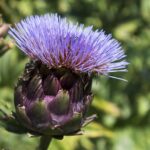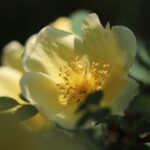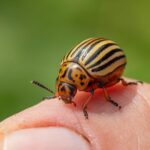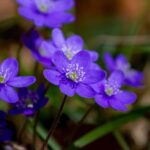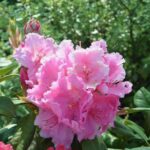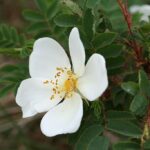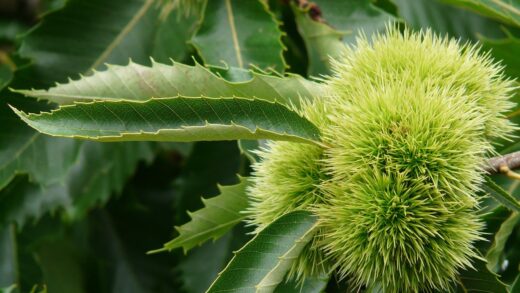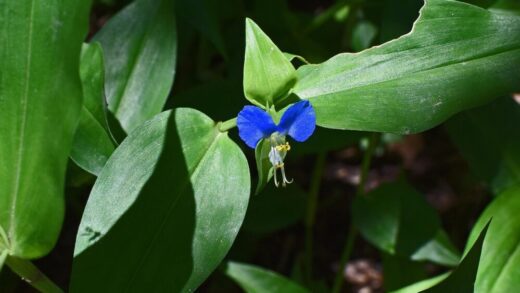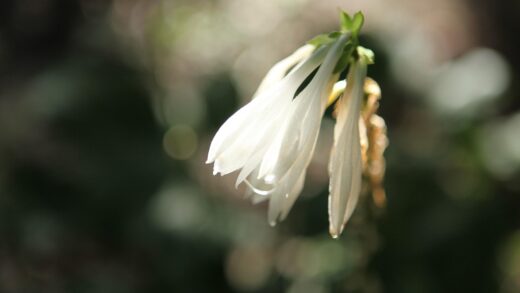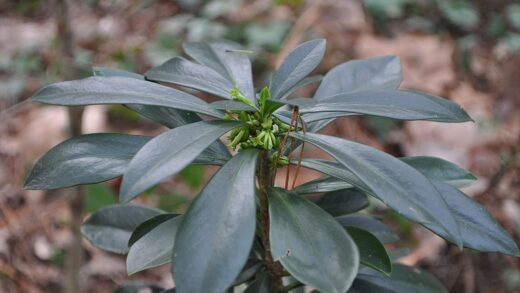Pruning and cutting back American pokeweed are essential management practices that allow the gardener to control its size, shape, and spread. This is not a plant that is pruned in the traditional sense to encourage bushy growth or more flowers, like a rose or a hydrangea. Instead, pruning pokeweed is primarily about containment, safety, and sanitation. Given its potential to grow to a massive size in a single season and its ability to spread via seed, a thoughtful approach to cutting it back is crucial for maintaining it as a welcome garden feature rather than a dominant weed. The main pruning activities are thinning new shoots in the spring, potentially reducing its height mid-season, removing flower heads to prevent seeding, and cutting the entire plant to the ground at the end of the year.
The annual cycle of pokeweed management begins in the spring. As the weather warms, multiple thick, reddish shoots will emerge from the ground where the perennial taproot is located. This is the first opportunity for control. Allowing all of these shoots to grow will result in a very dense, multi-stemmed plant. For a more controlled and arguably more architectural appearance, you can select the strongest three to five shoots to keep and prune the rest off at ground level. This thinning process opens up the plant, improves air circulation (which helps prevent fungal diseases), and concentrates the plant’s energy into fewer, stronger stems.
As the plant grows through the summer, you may find that its height becomes overwhelming for its location. While not a common practice, it is possible to reduce its height by pruning the main stems back in early to mid-summer. You can cut a stem back to just above a leaf node, and the plant will typically resprout from that point, resulting in a slightly shorter and bushier form. However, this will delay or potentially reduce the flowering and berry production on the pruned stems. This type of pruning is best reserved for situations where the plant’s height is causing a significant issue, such as blocking a view or pathway.
The most critical pruning task for controlling the spread of pokeweed is the removal of the flower or berry clusters. This can be done at two stages. You can prune off the long racemes of flowers as soon as they finish blooming to prevent any berries from forming at all. Alternatively, if you enjoy the ornamental look of the dark purple berries, you can wait until they have colored up but remove the entire stalks before the birds have a chance to eat them and disperse the seeds. This single act is the most effective way to prevent dozens of unwanted pokeweed seedlings from appearing all over your garden the following year.
Spring shoot thinning
Spring shoot thinning is a proactive pruning technique that sets the stage for a well-managed American pokeweed plant for the entire season. In early to mid-spring, you will see a cluster of vibrant, asparagus-like shoots emerging from the plant’s crown. It is common for a mature plant to send up a dozen or more of these shoots. If left to their own devices, they will all grow, creating a dense, impenetrable thicket. This density can lead to poor air circulation, making the plant more susceptible to fungal diseases, and can create a less aesthetically pleasing, cluttered look.
More articles on this topic
The process of thinning is simple. Once the shoots have reached a height of about 15 to 20 centimeters, examine the cluster and decide which ones you want to keep. Look for the thickest, healthiest, and best-spaced shoots. The ideal number will depend on your desired look, but thinning to between three and five main stems is a common practice. This will result in a more open, vase-shaped plant that allows you to appreciate the form and color of the individual stems.
Using a sharp, clean knife or a pair of pruners, cut the unwanted shoots off right at the soil level. Be careful not to damage the crown of the plant or the stems you have chosen to keep. The removed shoots should be disposed of carefully due to their toxicity; do not place them in your compost. This early intervention is quick and easy, and it has a profound impact on the plant’s structure and health for the rest of the year.
By thinning the shoots in the spring, you are effectively directing all of the taproot’s stored energy into a smaller number of stems. This results in those selected stems growing exceptionally thick, strong, and tall. They will be better able to support the weight of the large leaves and eventual berry clusters, reducing the likelihood of the plant bending or breaking in summer storms. This simple act of selective pruning is one of the most effective ways to cultivate a truly architectural and manageable pokeweed specimen.
Managing height and size mid-season
While the primary pruning is done in spring and fall, there may be circumstances where you need to manage the height and size of your American pokeweed during the summer. A healthy plant in a good location can easily exceed two and a half meters in height, which might be taller than desired for a particular garden design. If you find your plant is becoming too tall, you can perform a type of pruning known as “topping” or “pinching back,” although it should be done with a clear understanding of the consequences.
More articles on this topic
The best time to reduce the plant’s height is in early to mid-summer, before it has invested significant energy in producing its flower buds. Using a clean pair of pruners, you can cut the main stem back to a desired height. It is important to make your cut just above a leaf, as this is where new growth will emerge. The plant will respond to this cut by sending out side shoots from the leaf axils below the cut, which will result in a plant that is shorter, but also wider and bushier.
You should be aware that this type of mid-season pruning will affect the plant’s flowering and fruiting. Topping the plant will delay the formation of flowers on the pruned stem. It may also result in smaller flower and berry clusters compared to an unpruned stem. If the dramatic, drooping berry clusters are your main goal, you should avoid this type of pruning. However, if controlling the plant’s physical size is more important, then it is a viable management technique.
An alternative to pruning the main stem is to selectively remove some of the large lower leaves if the plant is becoming too wide and is encroaching on its neighbors. Removing a few of the oldest, largest leaves at the base of the plant can open up the space around it without affecting the main growing tips where the flowers will form. As with any handling of the plant, always wear gloves to protect your skin from the potentially irritating sap.
Deadheading for control
In the context of American pokeweed, “deadheading” takes on a critical role, shifting from a practice to encourage more blooms to a vital method for controlling its spread. The plant’s primary method of propagation is through seeds, which are prolifically produced within its attractive dark purple berries. Birds readily consume these berries and then disperse the seeds far and wide. Therefore, the most responsible way to grow pokeweed in a garden setting is to intervene in this cycle by removing the reproductive parts before the seeds can be spread.
You have two main strategies for this. The first and most foolproof method is to remove the flower stalks, or racemes, as soon as the small, whitish-pink flowers have faded. You can simply snip off the entire stalk at the point where it joins the main stem. This action completely prevents the formation of berries and seeds, thus eliminating any chance of the plant self-sowing. The downside of this approach is that you will miss out on the highly ornamental display of the dark, glossy berry clusters in the autumn.
The second strategy offers a compromise. You can allow the berries to develop and ripen on the plant to enjoy their aesthetic value. The clusters of dark fruit contrasting with the magenta stems is a highlight of the autumn garden. However, this approach requires vigilance. You must monitor the berries and the local bird population, and you must commit to removing the berry-laden stalks before the birds have stripped them clean. This is a timing game; wait too long, and the seeds will be gone. The safest bet is to cut them off as soon as they are fully colored and you have enjoyed their appearance for a week or two.
Whichever method you choose, the removed flower or berry stalks should be disposed of in the trash, not the compost bin. This ensures that the seeds are removed from your property and cannot germinate elsewhere. This simple act of deadheading or fruit removal is the single most important pruning cut you will make all year. It is the key to being a responsible pokeweed grower and preventing this beautiful plant from becoming an invasive problem for you and your neighbors.
The final cutback for winter
The final and most definitive pruning act for American pokeweed is the end-of-season cutback. This is performed in late autumn or early winter, after the first hard, killing frost. This frost signals the end of the plant’s growing season, causing the leaves to drop and the stems to wilt and blacken. At this point, the plant has successfully transported all of its energy reserves down into the perennial taproot for winter storage, and the above-ground portions are officially dead.
Once the plant is in this state, the entire top growth should be cut down to the ground. Using a strong pair of loppers or a pruning saw, cut all the thick stems back to a height of about five to ten centimeters. Leaving a short stub makes it easier to remember the plant’s location during the winter months. The hollow stems are typically soft and easy to cut at this stage. This process is not for the health of the plant—it would survive just fine without it—but for the health and tidiness of your garden.
This final cutback serves several important purposes. First, it is a crucial act of garden sanitation. The dead stems and foliage can provide a place for fungal spores and pest eggs to overwinter. By removing all of this debris, you help to reduce the potential for disease and pest issues in the following spring. It creates a clean slate for the new season’s growth.
Second, the cutback is your last chance to control seed dispersal. Even if you were diligent about removing berry clusters, a few might have been missed. Cutting down and disposing of all the stems ensures that any remaining berries are removed from the garden before they can be eaten by winter birds or drop to the ground. This final, decisive cut concludes the plant’s annual cycle and prepares the garden bed for its winter rest, with the promise of a powerful resurgence from the dormant root come spring.








